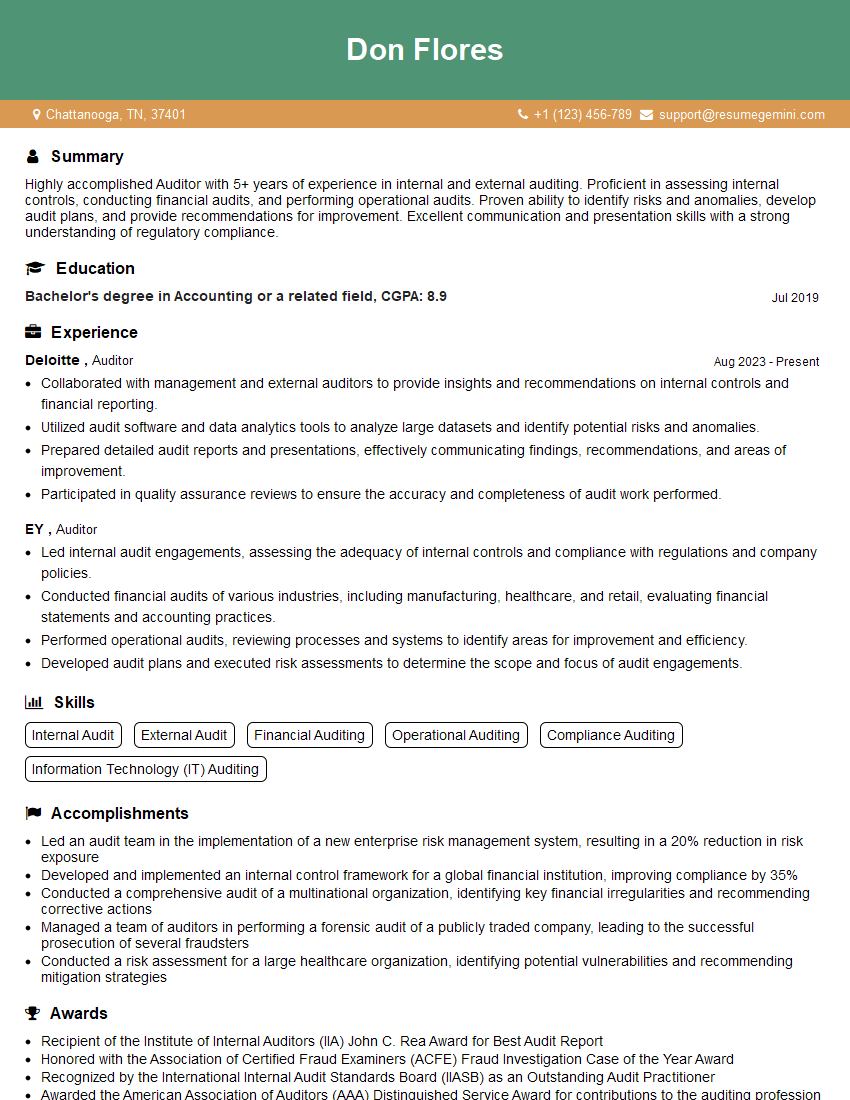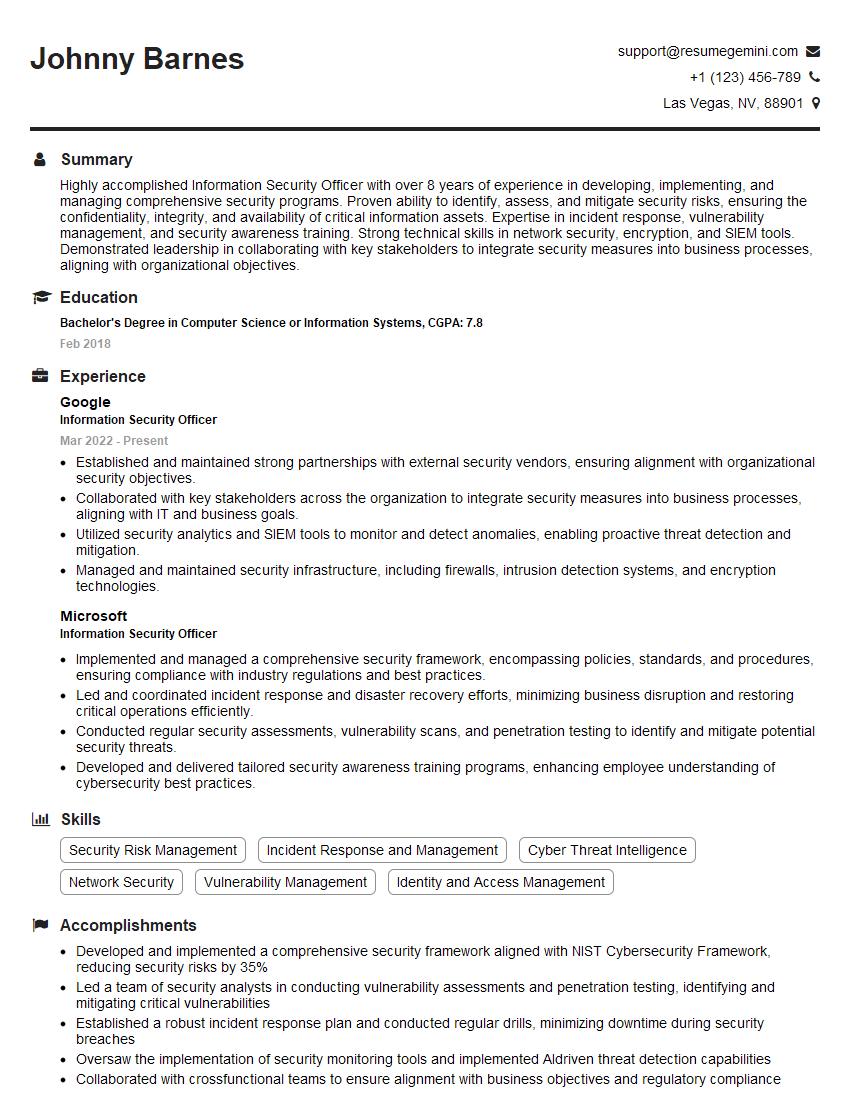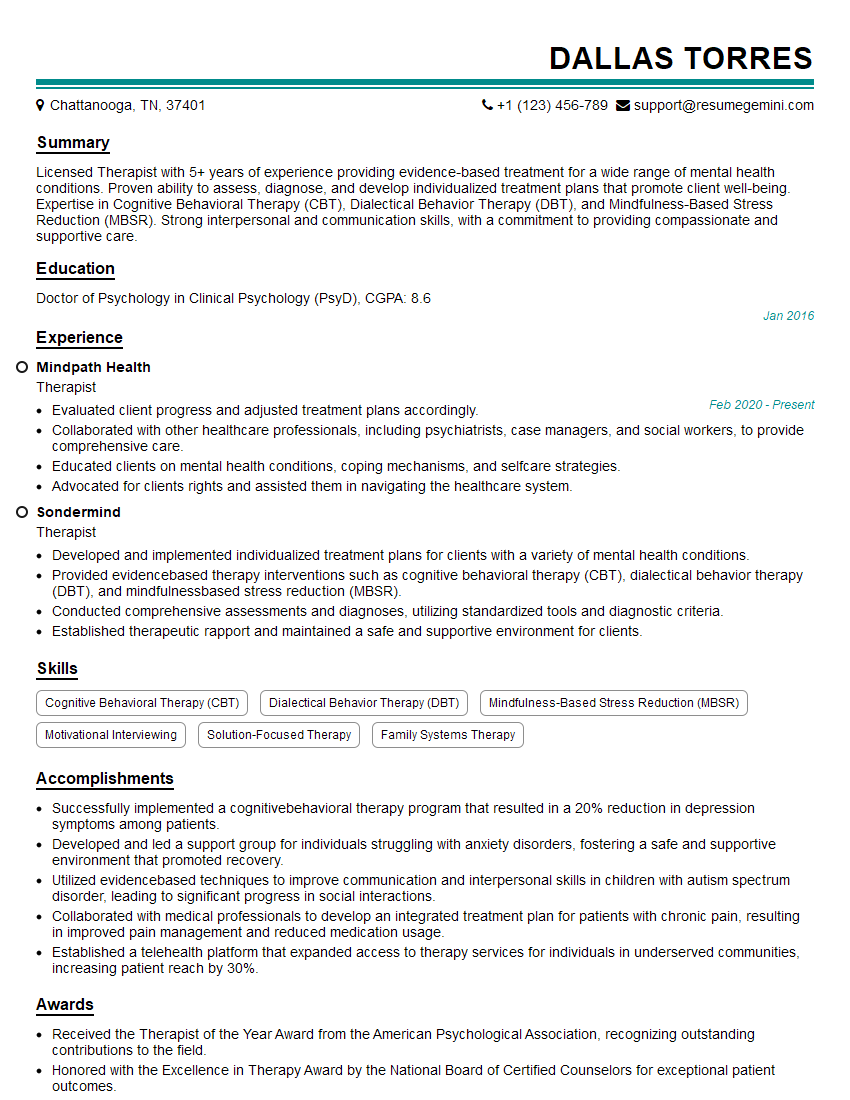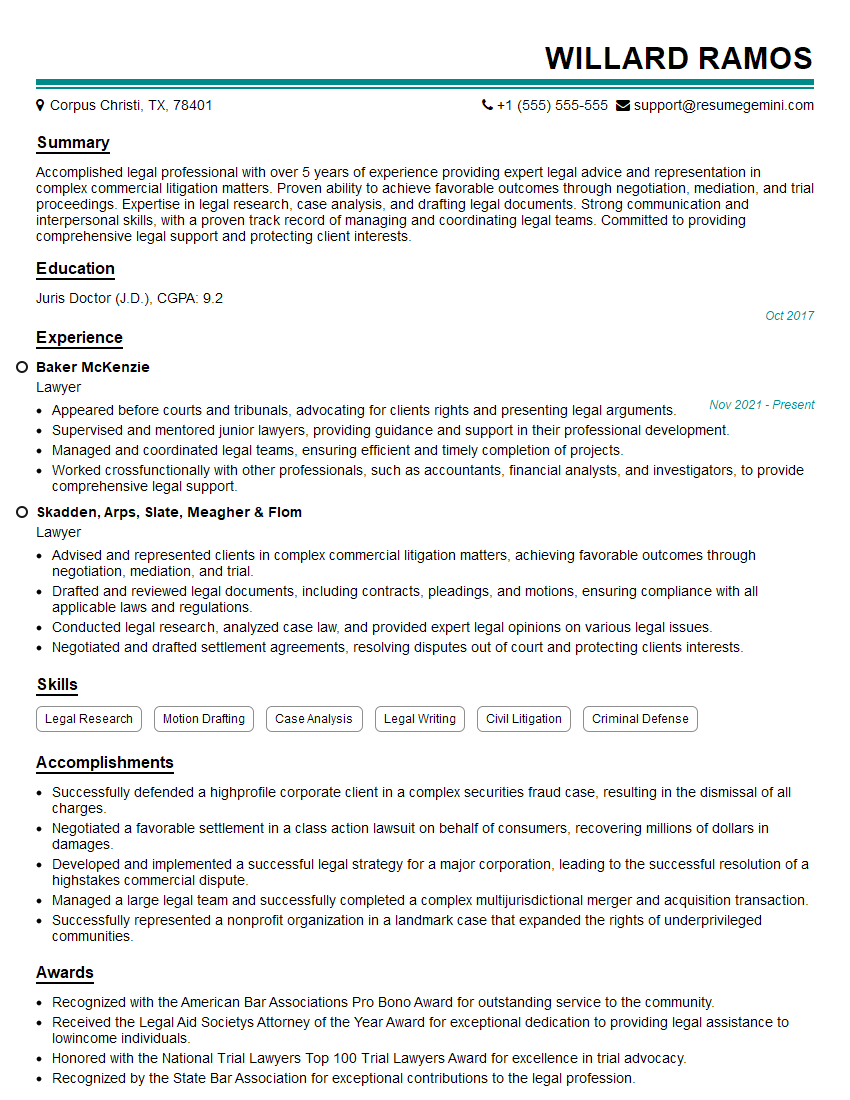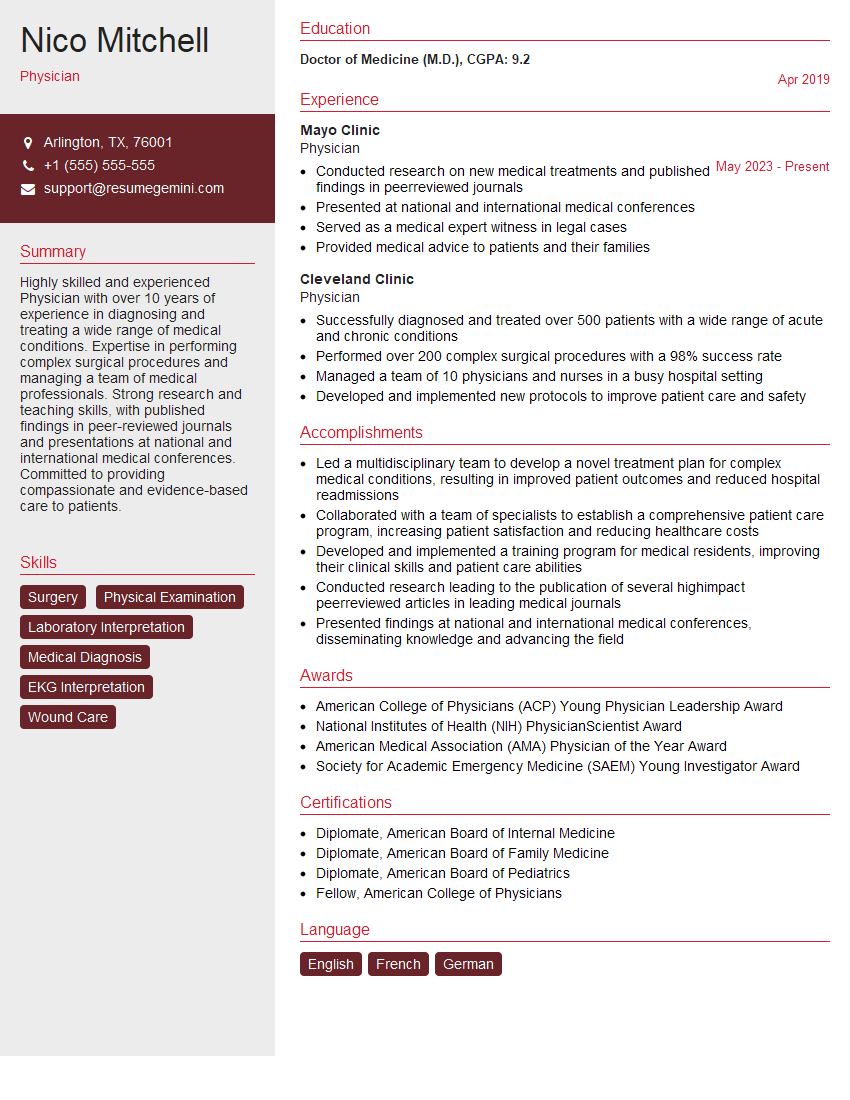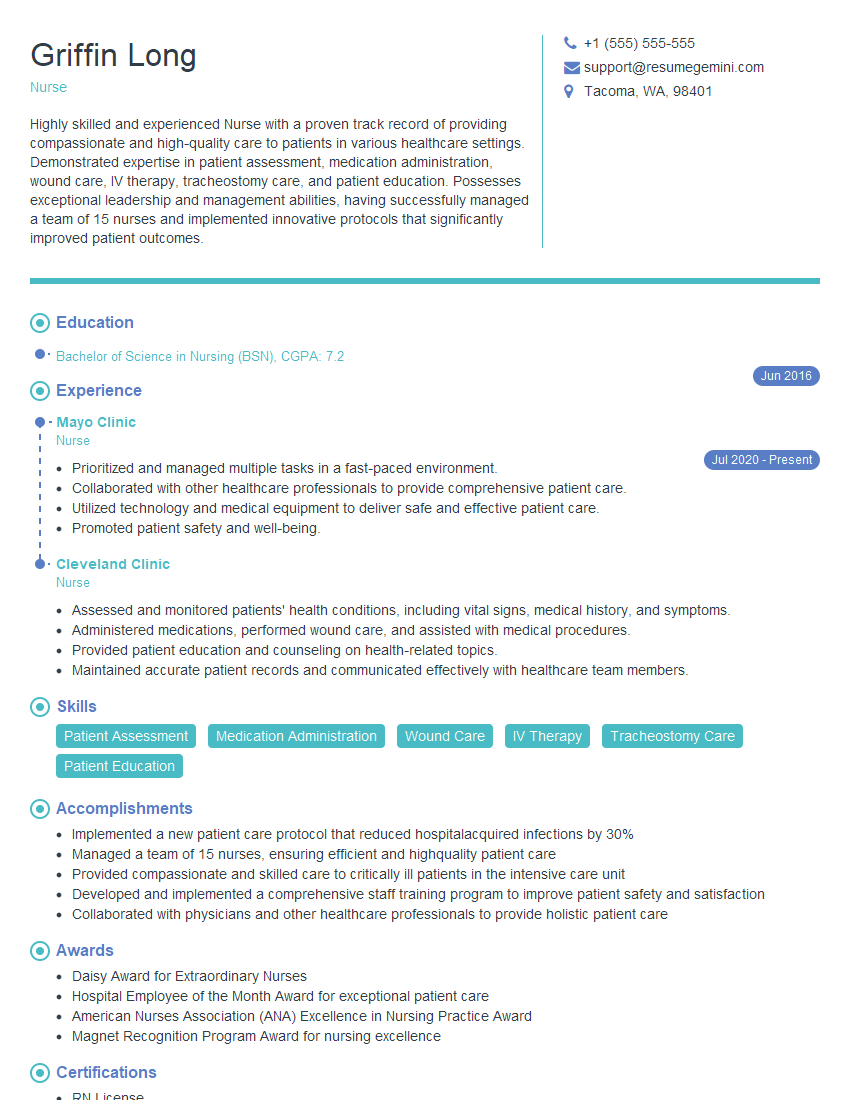Unlock your full potential by mastering the most common Ability to work in a confidential environment interview questions. This blog offers a deep dive into the critical topics, ensuring you’re not only prepared to answer but to excel. With these insights, you’ll approach your interview with clarity and confidence.
Questions Asked in Ability to work in a confidential environment Interview
Q 1. Describe your experience handling confidential information in previous roles.
Throughout my career, I’ve consistently worked with highly sensitive information. In my previous role at Acme Corporation, for example, I managed the personal data of thousands of clients, adhering strictly to internal protocols and relevant data protection regulations. This involved handling everything from financial records and medical information (under strict HIPAA compliance) to confidential employee performance reviews. My responsibilities included data entry, processing, and archiving, all performed with a meticulous focus on security and privacy. I was regularly audited and consistently exceeded expectations in maintaining confidentiality. In my prior position at Beta Solutions, I handled intellectual property, including trade secrets and patent applications, requiring an even stricter level of confidentiality and discretion.
- Strict adherence to access control protocols: I only accessed data necessary for my specific tasks, never exceeding authorized permissions.
- Secure data handling practices: I implemented strong passwords, used encrypted drives when necessary, and always logged out of systems when leaving my workstation.
- Regular security training: I consistently participated in and completed all mandatory security and data privacy training sessions, ensuring my knowledge base remains current.
Q 2. How would you react if you accidentally accessed confidential information you weren’t authorized to see?
Accidental access to unauthorized confidential information would trigger an immediate and precise response. My first action would be to immediately cease all activity and refrain from accessing or copying any information. I would then report the incident to my supervisor and the relevant security personnel, providing them with all the necessary details, including the time, method, and the nature of the accessed information. This prompt reporting is critical for initiating a thorough investigation and mitigating any potential harm. Following the reporting, I would fully cooperate with the investigation and any subsequent remedial actions.
Q 3. What measures would you take to ensure the confidentiality of sensitive data?
Ensuring the confidentiality of sensitive data involves a multi-layered approach. My strategy revolves around proactive measures, and includes:
- Access Control: Implementing strong password policies, multi-factor authentication, and role-based access controls to limit access to only authorized individuals and systems.
- Data Encryption: Using encryption both in transit and at rest to protect data from unauthorized access, even if the device or system is compromised. This could include implementing end-to-end encryption or using secure cloud storage providers.
- Regular Security Audits: Conducting regular security audits and penetration testing to identify vulnerabilities and weaknesses before they can be exploited.
- Employee Training: Providing comprehensive security awareness training to all employees, reinforcing best practices for handling sensitive data, including phishing awareness and password management.
- Data Loss Prevention (DLP) Tools: Utilizing DLP tools to monitor and prevent sensitive data from leaving the organization’s controlled environment.
- Physical Security: Maintaining secure physical access to servers, workstations and other sensitive equipment.
It’s crucial to remember that confidentiality isn’t a one-time measure; it’s an ongoing process requiring constant vigilance and adaptation to evolving threats.
Q 4. Explain your understanding of data protection regulations (e.g., HIPAA, GDPR).
I have a solid understanding of various data protection regulations, including HIPAA (Health Insurance Portability and Accountability Act) and GDPR (General Data Protection Regulation). HIPAA focuses on protecting the privacy and security of Protected Health Information (PHI) in the United States, mandating specific security measures and requiring organizations to provide individuals with control over their data. GDPR, on the other hand, is a broader regulation applying to personal data in the European Union, focusing on the principles of data minimization, purpose limitation, and accountability. It grants individuals significant rights regarding their personal data, including the right to access, rectification, erasure, and data portability. I understand the implications of these regulations and am adept at implementing the necessary security measures and procedures to ensure compliance.
Q 5. Have you ever had to deal with a breach of confidentiality? How did you handle it?
In a previous role, a minor breach of confidentiality occurred when an employee accidentally emailed a confidential client list to an external party. My immediate response was to initiate a full investigation, tracing the email and determining the extent of the data exposure. We then promptly notified the affected clients, and I collaborated with IT to implement additional security measures, including enhanced email filtering and employee retraining. We also conducted a thorough review of our existing security protocols to identify vulnerabilities and make the necessary improvements. Transparency with the clients and proactive remediation were key to mitigating the damage and regaining trust.
Q 6. Describe a situation where you had to maintain confidentiality despite pressure to disclose information.
During a legal investigation, I was under pressure to disclose confidential information relating to a client’s case. Despite considerable pressure from external parties, and even some internal questioning, I firmly maintained confidentiality, emphasizing the ethical and legal obligations of client confidentiality and the potential implications of a disclosure. I explained the potential legal repercussions and reputational damage that would result from a breach of confidentiality. This situation reinforced the importance of unwavering ethical conduct and the crucial role of legal counsel in navigating complex scenarios.
Q 7. How do you balance the need for confidentiality with the need for transparency?
Balancing confidentiality and transparency requires a nuanced approach. While confidentiality is paramount to protect sensitive information and build trust, transparency is vital for accountability and building strong relationships. The key is to be transparent about the organization’s commitment to data privacy and the measures taken to protect sensitive information, while clearly outlining the limitations on what can be disclosed due to legal or ethical constraints. For instance, while I wouldn’t disclose specific client data, I could explain the general processes and measures in place to protect that data. This approach demonstrates a responsible balance between protecting sensitive information and maintaining open communication.
Q 8. What strategies do you use to protect confidential information both digitally and physically?
Protecting confidential information requires a multi-layered approach encompassing both digital and physical security. Think of it like guarding a valuable treasure – you need multiple locks and alarms.
Digital Security: This involves using strong, unique passwords for all accounts, enabling two-factor authentication wherever possible, encrypting sensitive data both in transit (using HTTPS) and at rest (using encryption software), regularly updating software and antivirus programs, and adhering to strict access control policies (limiting who can access what data). For example, I would never store sensitive client data on a personal, unencrypted device.
Physical Security: This focuses on the physical protection of documents and devices. It includes using locked filing cabinets for paper documents, secure shredding of sensitive documents before disposal, using password-protected computers and locking them when unattended, and controlling access to physical workspaces. I once worked on a project where we used biometric scanners to restrict access to the server room.
Regular security audits and employee training are also crucial components of a comprehensive strategy. These help to identify vulnerabilities and ensure everyone understands their responsibilities in maintaining confidentiality.
Q 9. How would you handle a request for confidential information from an unauthorized individual?
If an unauthorized individual requests confidential information, my response is immediate and firm. I would politely but definitively refuse the request, explaining that I’m bound by confidentiality agreements and company policy. I would then immediately report the incident to my supervisor, providing details of the request and the individual involved. Depending on the nature of the request and the individual, further action, such as involving security personnel, might be necessary.
For example, if a journalist called asking for client details, I would refuse and then notify my communications team. If a colleague I don’t know well asks for confidential information that’s outside their role, I would politely ask them to go through the appropriate channels.
Q 10. How do you ensure confidentiality when working remotely?
Maintaining confidentiality while working remotely demands even greater vigilance. It’s like securing your home office with the same level of protection as a corporate office. Key aspects include:
Using a secure Virtual Private Network (VPN) to encrypt all internet traffic.
Employing strong passwords and multi-factor authentication for all work-related accounts.
Ensuring my home workspace is secure, limiting access to authorized individuals only.
Using only company-approved devices and software.
Never discussing confidential information in public spaces.
Regularly updating software and security patches on all devices.
Regular communication with my supervisor and IT department to address any potential security concerns is also essential.
Q 11. What are the consequences of a breach of confidentiality in your field?
The consequences of a confidentiality breach can be severe, depending on the nature of the information and the industry. In my field, a breach could result in:
Legal repercussions: This could include lawsuits from affected parties and significant fines for non-compliance with regulations like GDPR or HIPAA.
Reputational damage: A loss of trust from clients and stakeholders, impacting future business opportunities.
Financial losses: This could involve costs associated with legal action, remediation efforts, and a potential drop in revenue.
Criminal charges: In extreme cases, criminal charges could be filed, leading to imprisonment.
The severity of these consequences underscores the critical importance of robust confidentiality protocols and unwavering adherence to them.
Q 12. How would you determine the level of confidentiality required for different types of information?
Determining the level of confidentiality requires careful consideration of several factors. I would typically use a classification system, categorizing information based on its sensitivity and potential impact if disclosed. This might include:
Public: Information readily available to the general public.
Internal: Information shared within the organization but not externally.
Confidential: Information that requires restricted access and should not be shared beyond authorized personnel.
Strictly Confidential: Highly sensitive information with the most restrictive access controls, often requiring specific authorization even within the organization. Examples include trade secrets, financial data, and personnel records.
The classification system is often determined by company policy and relevant legal regulations.
Q 13. Describe a time when you had to prioritize confidentiality over other competing priorities.
In a previous role, I was involved in a project where a tight deadline conflicted with the need to maintain stringent confidentiality during a critical data migration. While the pressure to meet the deadline was immense, I insisted on following the established protocols, even if it meant extending the project timeline slightly. This included meticulously verifying the identities of all individuals involved in the data transfer, carefully documenting each step of the process, and utilizing robust encryption methods. Ultimately, prioritization of confidentiality ensured the integrity of sensitive client data, even if it meant a slightly delayed project completion. The project was ultimately successful and the client expressed satisfaction with our meticulous adherence to security protocols.
Q 14. What protocols or procedures do you follow to maintain confidentiality?
Maintaining confidentiality is ingrained in my professional practice. I follow several protocols and procedures, including:
Adherence to company policies and procedures: This includes understanding and implementing all relevant data protection policies.
Secure handling of physical documents: Using locked cabinets, secure disposal methods, and minimizing the movement of paper documents.
Secure digital practices: Employing strong passwords, encryption, and access control measures.
Reporting breaches: Immediately reporting any suspected or actual breaches of confidentiality to appropriate personnel.
Ongoing training: Participating in regular security awareness training to stay abreast of evolving threats and best practices.
My approach is proactive and preventative, ensuring that confidentiality is not just an afterthought but an integral part of my daily work processes.
Q 15. How do you verify the identity of individuals requesting confidential information?
Verifying the identity of individuals requesting confidential information is paramount. It’s a multi-layered process that depends heavily on the sensitivity of the data. Generally, it involves a combination of methods, starting with initial identification using established credentials like employee IDs, access badges, or government-issued identification.
For higher-security requests, multi-factor authentication (MFA) is crucial. This might involve a one-time password (OTP) sent to a registered mobile device, a security question, or biometric verification. The specific methods are tailored to the risk level associated with the data and the individual’s access privileges.
For external requests, stringent verification procedures are essential. This could involve verifying their identity against official records, confirming their affiliation with the requesting organization, and utilizing secure communication channels to exchange sensitive information. Sometimes, a formal request letter on official letterhead, bearing the company seal and contact information, is necessary. The ultimate goal is to be certain that the requester is indeed who they claim to be and that their request is legitimate.
Career Expert Tips:
- Ace those interviews! Prepare effectively by reviewing the Top 50 Most Common Interview Questions on ResumeGemini.
- Navigate your job search with confidence! Explore a wide range of Career Tips on ResumeGemini. Learn about common challenges and recommendations to overcome them.
- Craft the perfect resume! Master the Art of Resume Writing with ResumeGemini’s guide. Showcase your unique qualifications and achievements effectively.
- Don’t miss out on holiday savings! Build your dream resume with ResumeGemini’s ATS optimized templates.
Q 16. Describe your experience using secure communication methods to protect confidential information.
Throughout my career, I’ve consistently utilized secure communication methods to handle confidential information. This includes using encrypted email services like those offering end-to-end encryption (E2EE). I understand the importance of avoiding unencrypted email for sensitive communications. For instance, I’ve relied on PGP encryption for particularly sensitive email exchanges, generating and verifying digital signatures to guarantee authenticity and data integrity.
In addition to email, I’ve extensively used secure file transfer protocols (SFTP) and virtual private networks (VPNs) to transmit and access confidential files securely. These measures protect the data both in transit and at rest. I always ensure that the encryption methods are up-to-date and aligned with best practices. For sensitive collaboration, I utilize secure collaboration platforms that offer robust access controls and audit trails, ensuring accountability and traceability. For example, I have leveraged platforms incorporating role-based access control (RBAC) to restrict access to specific individuals based on their job function and need-to-know basis.
Q 17. What is your understanding of ‘need-to-know’ principles related to confidential information?
The ‘need-to-know’ principle is fundamental to protecting confidential information. It means that access to sensitive data should be strictly limited to individuals who absolutely require it to perform their job duties. This approach reduces the risk of unauthorized disclosure and maintains the confidentiality of sensitive data.
For instance, if a project involves sensitive client data, only team members directly involved in the project’s tasks, such as project managers, developers, and designers working directly with the data, will be granted access. Other employees within the organization, even those in higher management positions, would not have access unless there is a specific and justifiable reason. The principle promotes data security by reducing the number of individuals who could potentially breach confidentiality. Implementation often involves robust access control systems and strict guidelines on data sharing.
Q 18. How do you manage confidential information across different platforms and systems?
Managing confidential information across various platforms and systems necessitates a structured approach and strong adherence to security protocols. My strategy involves utilizing secure cloud storage with robust encryption and access controls. I leverage cloud platforms that comply with relevant security standards such as ISO 27001 or SOC 2, ensuring that the data is protected both in transit and at rest.
When dealing with multiple systems, I employ data encryption at rest and in transit. This is crucial to protect data from unauthorized access, even if one system is compromised. I also utilize strong passwords or multi-factor authentication for all accounts and regularly review and update access permissions to ensure that only authorized personnel have access to the required information. Consistent monitoring of access logs is also a crucial part of maintaining data security across platforms. The goal is to create a layered security approach that minimizes the risk of data breaches across all systems.
Q 19. What training have you received on handling confidential information?
Throughout my career, I’ve received comprehensive training on handling confidential information. This includes mandatory courses on data security best practices, compliance regulations (such as GDPR, HIPAA, etc.), and ethical considerations related to handling sensitive data. I’ve attended workshops covering secure communication methods, information security policies, and incident response protocols.
These training programs frequently involved hands-on exercises and simulations, reinforcing the practical application of theoretical knowledge. For example, I’ve participated in phishing awareness training to recognize and avoid potential security threats and simulated data breach scenarios to understand how to respond effectively. These experiences have significantly sharpened my understanding of confidentiality and data security protocols. Furthermore, I routinely review updates and participate in refresher courses to stay abreast of the latest threats and best security practices.
Q 20. How do you ensure the secure disposal of confidential documents?
Secure disposal of confidential documents is critical. For paper documents, I utilize a cross-cut shredder to ensure that the information cannot be reconstructed. The shredded material is then disposed of securely, usually through a certified waste disposal service that specializes in confidential waste management. For digital documents, I employ secure deletion methods that overwrite the data multiple times, making recovery practically impossible.
Furthermore, I ensure that hard drives containing confidential information are properly wiped using specialized data destruction software before disposal or repurposing. This process renders the data irretrievable, preventing any potential security breaches. I always ensure that the disposal method complies with all relevant regulations and company policies. The goal is to completely erase the information beyond any recovery possibility. This rigorous process mitigates the risk of sensitive data falling into the wrong hands.
Q 21. How familiar are you with encryption and data loss prevention (DLP) tools?
I am very familiar with encryption and data loss prevention (DLP) tools. My experience encompasses various encryption techniques, including symmetric and asymmetric encryption, and I understand the strengths and weaknesses of each. I’m proficient in using encryption software to protect data both in transit and at rest. This includes employing strong encryption algorithms and key management best practices.
Regarding DLP tools, I have experience with implementing and managing various solutions to prevent sensitive data from leaving the organization’s controlled environment. These tools allow for monitoring data movement, identifying sensitive information, and preventing unauthorized transfers or downloads. I’m familiar with their features, including data classification, policy creation, and reporting capabilities. I understand how to configure these tools to enforce data loss prevention policies and manage exceptions as needed. I can use this knowledge to ensure compliance with security and regulatory requirements.
Q 22. How would you identify and mitigate potential risks to confidentiality?
Identifying and mitigating confidentiality risks requires a proactive and multi-layered approach. It starts with a thorough risk assessment, identifying all potential vulnerabilities. This includes assessing who has access to sensitive information, how it’s stored (physical and digital), and the potential pathways for unauthorized disclosure.
Mitigation strategies include implementing strong access controls, like multi-factor authentication and role-based access, using encryption for sensitive data both in transit and at rest, and regularly reviewing and updating security protocols. For example, I’d ensure that all documents containing confidential information are stored securely, either in locked cabinets or encrypted folders, accessible only to authorized individuals. Additionally, I would regularly review and update access permissions to ensure only those who require access maintain it.
Another key aspect is employee training. Educating staff on safe handling of sensitive information is crucial, covering topics like phishing scams, social engineering, and proper disposal of physical documents.
Finally, regular security audits and penetration testing can help identify weaknesses in the system and allow for proactive remediation.
Q 23. How do you maintain confidentiality when working in a team environment?
Maintaining confidentiality in a team environment demands open communication, clear guidelines, and mutual respect for privacy. It’s crucial to establish clear protocols from the outset regarding what constitutes confidential information and how it should be handled. This might involve designating specific individuals responsible for handling sensitive data or creating a secure communication channel for confidential discussions. It’s never acceptable to share confidential information casually during informal conversations, and even seemingly innocuous topics may contain sensitive insights.
Think of it like a team working on a top-secret project. While collaboration is key, each team member understands the sensitivity of the information and takes responsibility for protecting it. We use secure file sharing systems, encrypted emails, and avoid discussing confidential matters in public spaces.
Regular team meetings can reinforce confidentiality protocols and address any concerns. Building a culture of trust and accountability is paramount – everyone understands the potential consequences of a breach.
Q 24. What are some common mistakes people make when handling confidential information?
Common mistakes in handling confidential information often stem from carelessness, lack of awareness, or inadequate training. These include:
- Leaving sensitive documents unattended: Leaving laptops or printouts in public areas, or not securely locking filing cabinets. For example, leaving a report containing client financial information on a desk overnight could lead to a breach.
- Using unsecured networks or devices: Accessing confidential data on public Wi-Fi or using personal devices without proper security measures.
- Failing to shred documents properly: Improper disposal of physical documents containing confidential information can expose sensitive details to unauthorized individuals.
- Sharing information inappropriately: Disclosing sensitive information to unauthorized individuals, either verbally or electronically, such as discussing client matters with friends or family.
- Neglecting password security: Using weak passwords or failing to update them regularly, allowing unauthorized access to confidential data.
- Ignoring phishing scams or social engineering attempts: Falling prey to phishing emails or other deceptive tactics designed to obtain confidential information.
Q 25. How would you educate others about the importance of confidentiality?
Educating others about confidentiality is crucial, and my approach involves a combination of training sessions, clear policies, and ongoing reinforcement. I’d start by outlining the organization’s confidentiality policy, explaining the legal and ethical implications of breaches and the potential consequences. The training would include practical examples of scenarios where confidentiality is at risk, like phishing scams or social engineering tactics. Interactive workshops and quizzes help ensure comprehension and retention.
I also believe in regular reinforcement. This could involve email reminders, short training modules, and inclusion of confidentiality guidelines within all relevant documentation. By making it an ongoing conversation, rather than a one-time training event, we improve long-term adherence and reduce the risk of unintentional breaches.
Finally, clear reporting mechanisms should be established, allowing employees to raise concerns or report suspected breaches without fear of retribution.
Q 26. Describe your process for reporting a suspected breach of confidentiality.
My process for reporting a suspected breach of confidentiality follows a clear protocol. First, I’d immediately secure any compromised information to prevent further damage. Then, I would report the suspected breach to my designated supervisor or the organization’s security team, providing all relevant details. This would include the nature of the breach, when it was discovered, and any potential impact. It’s critical to be factual, detailed, and avoid speculation.
Depending on the severity, the organization may engage in further internal investigation or involve external cybersecurity experts. Throughout the process, I’d cooperate fully with the investigation team, providing any information or assistance needed. Transparency and quick action are essential in mitigating the potential damage of a breach.
Q 27. What personal qualities do you possess that enable you to maintain confidentiality effectively?
Several personal qualities contribute to my ability to maintain confidentiality. Discretion is paramount; I understand the importance of keeping sensitive information private and only sharing it with authorized individuals. I also possess strong integrity, adhering to ethical guidelines and never compromising confidential information for personal gain or other reasons. I am highly organized, ensuring that sensitive documents are properly stored and handled with care.
Moreover, I am attentive to detail, making me mindful of potential risks to confidentiality, and proactive in preventing such risks. I am also a strong team player, capable of working collaboratively with others to maintain a culture of confidentiality within a team environment.
Q 28. How would you demonstrate your commitment to confidentiality in a new role?
In a new role, I would demonstrate my commitment to confidentiality by actively participating in any security training or briefings, seeking clarity on the organization’s confidentiality policies and procedures. I’d promptly inquire about the organization’s security protocols, including data storage, access controls, and incident reporting procedures. This proactive approach would signal my willingness to learn and adhere to the established guidelines from the outset.
Beyond compliance, I would actively promote a culture of confidentiality through my actions and interactions with colleagues. By setting a positive example and consistently demonstrating responsible handling of sensitive information, I can contribute to a secure work environment.
Key Topics to Learn for Ability to Work in a Confidential Environment Interview
- Understanding Confidentiality Agreements: Learn the different types of confidentiality agreements (NDAs, etc.) and their implications for your actions and responsibilities.
- Practical Application of Confidentiality: Discuss scenarios where you’ve handled sensitive information, highlighting your discretion and adherence to company policies. Consider examples from previous roles or volunteer experiences.
- Data Security Practices: Demonstrate your understanding of secure data handling, including password protection, secure data storage, and responsible email communication.
- Maintaining Professional Boundaries: Explain how you establish and maintain professional boundaries to protect confidential information, both within and outside of the workplace.
- Recognizing and Responding to Confidentiality Breaches: Describe your approach to identifying potential breaches and the steps you would take to mitigate any risks.
- Ethical Considerations: Discuss the ethical implications of handling confidential information and your commitment to maintaining integrity.
- Technology and Confidentiality: Understand the role technology plays in maintaining confidentiality and the security measures you would implement.
Next Steps
Mastering the ability to work in a confidential environment is crucial for career advancement in numerous fields. Demonstrating this skill confidently during interviews significantly boosts your chances of securing your desired role. To enhance your job prospects, focus on creating an ATS-friendly resume that effectively highlights your experience and commitment to confidentiality. ResumeGemini is a trusted resource that can help you build a professional resume tailored to showcase your skills. We provide examples of resumes specifically designed to highlight experience in maintaining confidentiality, allowing you to craft a compelling application that stands out from the competition.
Explore more articles
Users Rating of Our Blogs
Share Your Experience
We value your feedback! Please rate our content and share your thoughts (optional).
What Readers Say About Our Blog
This was kind of a unique content I found around the specialized skills. Very helpful questions and good detailed answers.
Very Helpful blog, thank you Interviewgemini team.






